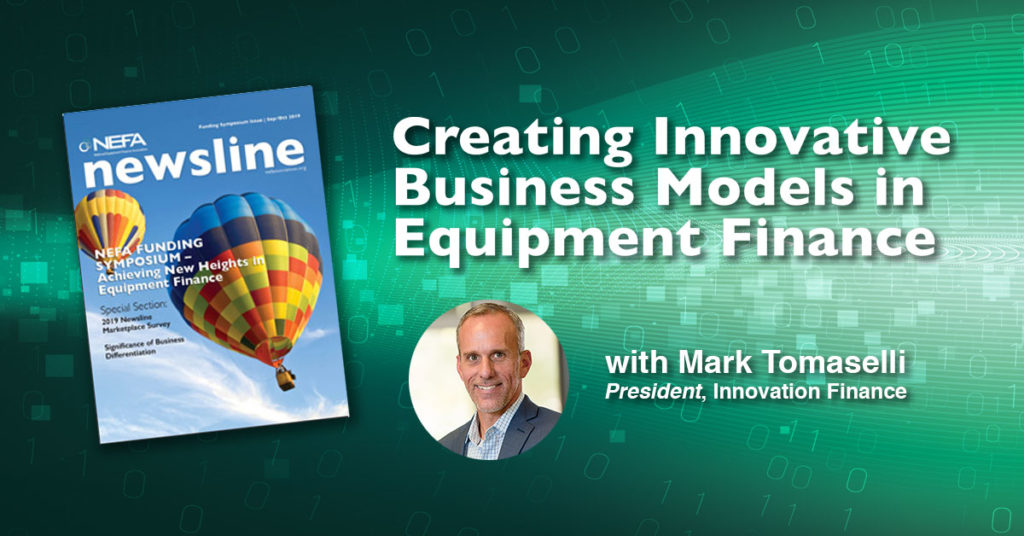Creating transformative business models is a rare achievement. In this Q&A, Newsline sat down with Mark Tomaselli, President of Innovation Finance USA LLC, to learn about the importance of building new business models and to get a look at its QuickFi platform. These are some excerpts from that interview.

We’ve heard you mention that QuickFi represents a new business model. What is the importance of a new business model?
We believe a new business model is the most important aspect of an innovative company. Everyone talks about technology; however, new technology itself is important only to the extent it enables new business models, which better serve the customer. Customers prefer the experience they obtain from the business model, not the underlying technology that enables it.
Business models are also hard to change. …very hard to change! Netflix became famous for changing its business model, precisely because it is such a rare accomplishment. It almost never happens. Having spent time in large companies — both early in my career and after we sold First American Equipment Finance to City National Bank a few years ago — I was able to gain firsthand appreciation for how difficult it is for any large company to change its business strategy. Even with highly respected leadership and a loyal workforce, many factors preclude adoption (or even serious consideration) of new business strategies.
Companies are organized to serve the market in a specific way (a way that has worked in the past). They are frequently unable to conduct serious discussions about different business models requiring different people and different resources. Except in the case of a startup, business leadership is 99 percent about incremental improvement. Discussions about technology tend to be 99 percent about cost savings and incremental process improvements. New business strategies involving transformative strategy changes rarely occur. Top business leaders don’t often get the opportunity to think strategically, unless they are starting from scratch.
Several factors preclude large companies from contemplating or adopting new business models, including: organizational design (excessive hierarchy), corporate culture (an expectation for topdown or command-and-control leadership) and lack of experience with data-based decision-making in small teams (lack of willingness, permission or incentive to make frequent small mistakes). Loyal employees come into work each day prepared to add value by doing the activities they learned yesterday. When technology and customer preferences change rapidly, it’s difficult to make the kind of pivot that small agile start-up companies (which have not yet experienced much success) often make. These pivots are critical when the market you serve changes.
Perhaps this explains why taxi companies didn’t imagine or build Uber, and hotel companies didn’t imagine or build Airbnb. Likewise, we understood that our last company, as successful as it was, isn’t likely to lead transformational change in equipment finance. So, we left to join Innovation Finance USA LLC and to create QuickFi. To attempt such an ambitious task, we knew we needed to start over. We asked ourselves, what is the ultimate customer experience? And, how might we create it?
What is the QuickFi business strategy?
The QuickFi strategy is based on speed, transparency and trust.
Speed. QuickFi customers are in control. They start and finish the financing process when they wish. The platform is available 24/7/365. Customers can process transactions that previously took two or three weeks (or longer) in only three minutes, anytime, anyplace. If they want support, it is always available via live chat or telephone.
Transparency. In commercial lending today, loan officers and salespeople are often relegated to negotiating pricing and hidden
fees with customers in what is often an unpleasant and inefficient adversarial buying process. So, we decided the new QuickFi business model would eliminate salespeople. We also eliminated all negotiation, in favor of a radically transparent and simplified customer buying process. We never negotiate against customers. We are always on the same side of the table with the customer.
Trust. During the past decade, some bank and commercial finance companies have lost their clients’ trust. QuickFi is exclusively
and obsessively focused on building trust with the highly valued clients we serve. We put the interests of our clients first in everything we do.
What does the future hold?
Nothing was easy during our first 18 months. And nothing will likely be easy in months and years ahead. For all the chatter about disruption and fintech, we recognize that most successful fintech firms in adjacent industries have taken several years to establish value and to prove-out their business strategy.
If we build something great for our clients, we believe we will find success. Our clients will continue to be the exclusive focus of all our efforts. The feedback loops with our initial clients are greatly increasing our pace of development. Customer feedback is also identifying adjacent opportunities for future expansion and growth, both inside and outside of commercial equipment finance.
No one knows what the future holds, but everyone at QuickFi feels like we have an opportunity to help shape it. If successful, thousands of U.S. business seeking to grow their companies will have a fast, transparent fixed-rate option for equipment financing.
Published by the National Equipment Finance Association (NEFA)


